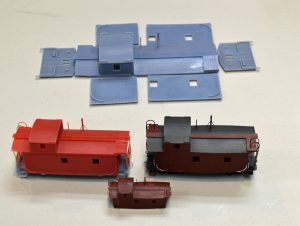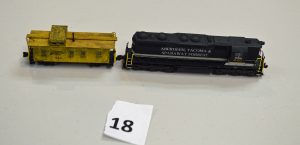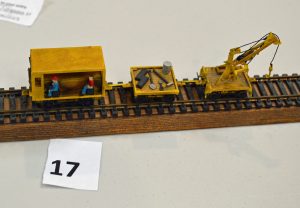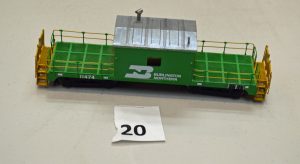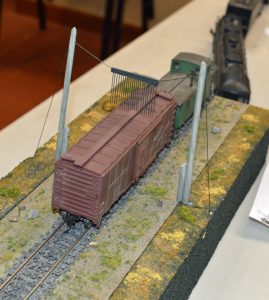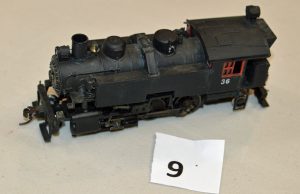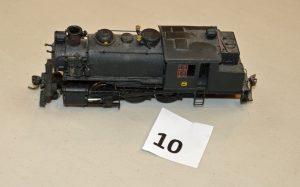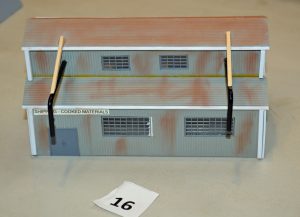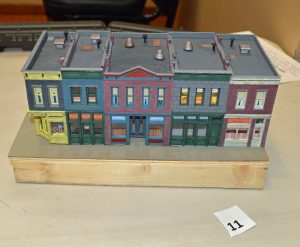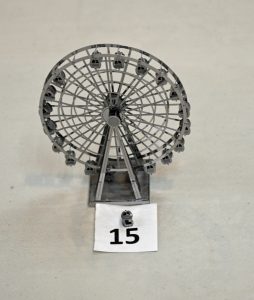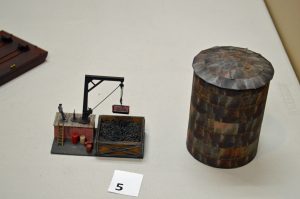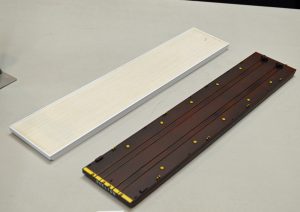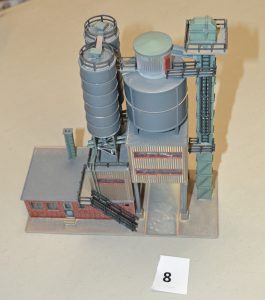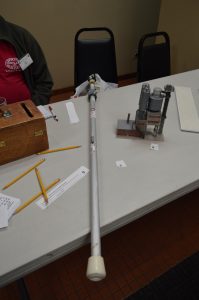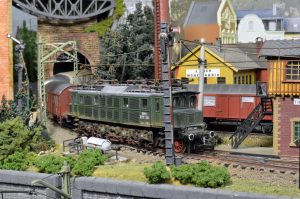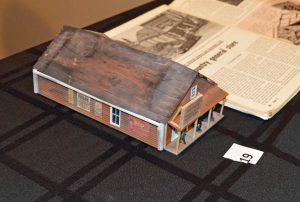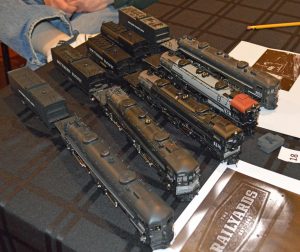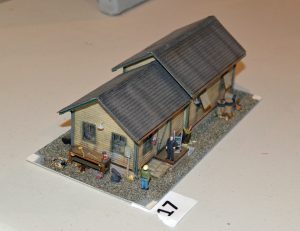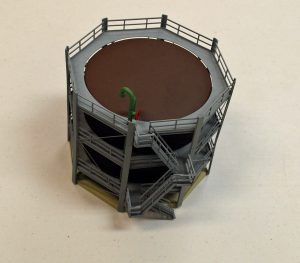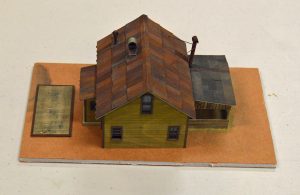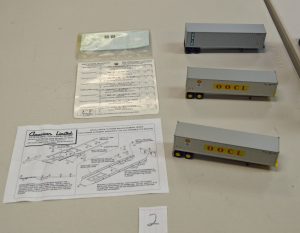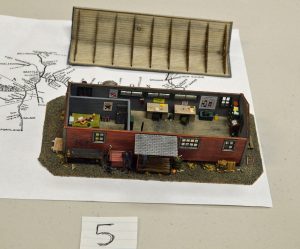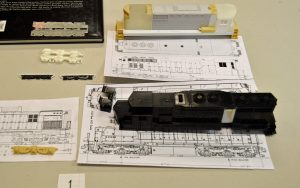Need to add a few ounces to your box cars (or any covered car)? Ten US pennies weigh almost exactly one ounce. Stick them together with superglue and cement them in the car. Since each penny weighs 1/10 oz., very accurate weighting can be done. This works well for box cars, tank cars, covered hoppers and gondolas, and passenger cars.
You are browsing archives for
Author: Dale Kraus
January Tacoma Clinic
Dale G. Kraus
Photos by author
Photos by author
The Paradise Lanes meeting room was full as host Kevin Klettke brought us to order (more or less.) Our friendly hobby shop proprietor, Rob, showed some interesting products, including an Athearn tunnel motor, a radio controlled Lionel Great Northern GP9, and a 3 car set from Kadee of TTX flats with M-1 Abrams tanks.
Jim Sabol introduced our guest speaker, John Hilbar who regaled us with stories of his long career on the Milwaukee Road. John began as a laborer and retired as a conductor on the Hoquiam local.
The modeler’s showcase had five entries.
Warren Kerr’s HO Speeder with DCC installed
Walt Huston’s N scale SD35 and Caboose
Chip VanGelder’s 3D printed cabooses in N and HO
Paul Vaughn’s On30 scratchbuilt switches (under construction)
Larry Sloan’s HO brass transfer caboose, painted for BN.
The next meeting will be 7PM, February 14. At Paradise lanes.
Sorry about the photos. I can’t get them to move. dgk
Clinic Report – November Tacoma Clinic
Dale G. Kraus
Photos by Author
It was a full house at the Paradise Lanes meeting room. MMR Gene Swanson gave a presentation on the prototypical use of telltales and how to model them using stripwood and thin music wire. He covered the history of telltales, when and where the railroads use them, and the several different designs used.
Rob, proprietor of Rob’s Trains and Hobbies, showed off the latest stuff available for Christmas.
The Modeler’s Showcase was well populated this month.
Gene’s Telltale
Dale’s logging lokeys
Warren Kerr’s “excursion” Cab forward with auxiliary water tenders
Kevin Levine”s “Beefonite” mining Co.
Gary Fox’s Merchants Row
Dennis Reeve’s mini (Z scale?) Micron Art ferris wheel
My apologies to Mitch Schoonejans for not having a picture of his Eiffel Tower. It was the largest model there, by far, and I FORGOT TO TAKE A PICTURE!! It looked to be 1:200 scale and stood over three feet high. I am abashed and embarrassed.
Next Clinic: Thursday, December 13. Dirty Santa will be there.
Clinic Report – October Tacoma Clinic
By Dale G. Kraus
Photos by author
Twenty-three modelers gathered at the Paradise Lanes to see a video presentation of the history of West Coast Steam Logging. Our own Jim Sabol had a significant part in producing the video, and many of the scenes were shot by him with a 16mm movie camera.
Prior to the presentation Rob, our local purveyor of model railroad stuff, show us several new items, the most interesting of which were weathered and graffitti’ed city water towers on “O”, “HO”, and “N” scales.
The Modeler’s Showcase had the following entries (All HO):
A small coaling stand and rusty ole’ water tank by yours truly
Two rail barges, one finished, one under construction , by Tyler Whitcomb
A finished and weathered cement plant (Faller kit) by Ken Levine. This was the model of the month.
Paul Vaughn showed us this I-Phone extension for getting above crowds at photo run-bys. It’s made from an old paint roller pole.
The next Tacoma clinic is 7 PM, November 8 at Paradise Lanes.
Cheap Car Weights
Dale G. Kraus
Many commercially available freight and passenger cars, and almost all scratchbuilt cars are lighter that they should be for good tracking. For “house” cars (Boxcars, reefers, and the like) there is a simple, cheap solution. The weight of ten U.S. cents (pennies) is almost exactly one ounce (oz.). Therefore one-half oz. is 5 pennies and one quarter oz. is 2-1/2 pennies. Just stack them up, super-glue them together, and cement the stacks inside that too-light car.
Murphy’s Law
May Tacoma Clinic Report
Dale Kraus
The May Tacoma clinic was held on May 10 at the Parkland Paradise Lanes.
What’s New at The Hobby Shop was presented by Rob, owner of Robs Trains and Hobbies, who presented several new N, H.O, and O scale care and structure kits.
This months’ clinic topic was “Fleet Weathering – easy, time saving techniques for large rolling stock fleets,” presented by clinic chairman Kevin Klettke. Using an eclectic mix of Acrylic paint, artist pastel chalks, weathering powders, earth tone artist oil paints, and Krylon and Rust-Oleum rattle-can sprays, Kevin demonstrated how he represented rusted scratches and dings, dirty, rusty roofs and underframes, and overall “grunginess.”
His presentation can be viewed at: http://wnrr.net/Fleetweatheringclinic.pdf
Bring-and-Brag has 3 entries ( we need more,everybody. BRING YOUR MODELS)
Scratchbuilt H.O. General Store by Ken Levine made using an old MR article.
Five H.O. SP AC4, 5, 11, and 12s from a variety of manufacturers by Warren Kerr
A super detailed H.O. yard storage shed kit by Leo Scafturon
The next Tacoma Clinic will be on June 14 at 7 PM in Paradise Lanes.
Don’t forget to attend the PNR regional convention on May 30 thru June 2 at the Jantzen Beach Red Lion in Portland, OR See: stumptown2018.org for details.
DCC de MYTHtified
Dale Kraus
Digital Command Control (DCC) is a boon to model railroaders. In it’s essence it is simple, straightforward, and user friendly [geekspeak for easy to use.] Nevertheless, several myths persist. Those who use DCC will chuckle at these, but many new model railroaders find them confusing. So without further ado, here, in no particular order, are the myths.
- Each locomotive will require a dedicated throttle. If I have five locos I need five throttles. No. Each operator will need a throttle, which can control any decoder equipped loco.
- DCC systems must be connected to a computer. No. The command station IS a single-purpose computer. It’s all you need to run your locos.
- Loco programming requires a computer. No. All basic programming can be done through the command station using the throttle that came with the set. You can use your computer for advanced programming, but it’s a “nice-to-have” and not a necessity.
- Older (pre-DCC) locomotives cannot be used. No. Any locomotive, be it 2-rail, 3-rail, DC or AC powered, can be converted. Some will require more work than others.
- The track must be re-wired and existing control panels removed. No. Existing wiring can be used. If your control panels are set up for multiple cabs set them all to the same cab and attach the DCC system to the inputs for that cab.
- “DCC friendly” turnouts must be used. No. If your layout runs fine with the current turnouts it will run fine on DCC. All-rail turnouts are OK too if insulated rail joiners are properly used.
- Blocks are unnecessary. No and Yes. Conventional DC blocking is overkill. The wiring can be simplified into maintenance/troubleshooting sections. e.g.: A town with a passing siding and several spurs can be wired as one section.
- DCC systems are not compatible with each other. All DCC systems will talk to all DCC decoders, regardless of brand. Generally, however, the command station and throttles must be the same brand.
Finally, remember that this is technology, not magic. If you’re using 2-rail all the rules concerning polarity, reversing sections, and insulation must be followed. But fear not, for there are devices available to overcome these problems.
New Location for Tacoma Clinic
Dale Kraus
Remember, the Tacoma clinic has moved. We will meet on Thursday, April 12 at
PARADISE BOWL 12505 Pacific Ave., Tacoma, WA 98444
The clinic starts at 7PM.
March Tacoma Clinic Report
Dale G. Kraus
Photos by author
March 8 found a full house at the Tacoma Clinic for our last meeting at the Pierce County Library annex. We will be moving in April to PARADISE BOWL, 12505 PACIFIC AVENUE, TACOMA WA, 98444. The meeting will start at 7PM, but you can come early and have a burger at their restaurant if you wish.
The March clinic was presented by Wain Miller. Wain explained how he was using Plexiglas to make control panels for Mike Highsmith’s Rainier Great Western. Automotive pin-striping tape is used to make mirror-image diagrams of the track on the “back” side of the panel. A base color (he used red) is sprayed over the diagram and the tape is then peeled off the Plexiglas. After the paint has set, contrasting colors (yellow and blue) are then sprayed over the unmasked areas. When dry, holes are drilled for the control buttons and indicator LED’s and the finished panel is framed. This is a fine clinic which deserves wider presentation. How about taking it to the Portland PNR convention, Wain?
Five modelers brought their work for the modeler’s showcase.
Scott Taylor: Kitbashed HO fuel oil tank
Jim Clowers: Detailed HO Kit
Gene Swanson: HO OOCL piggyback trailers
Leo Scafturon: HO yard office ( Model of the Month)
Paul Vaughn: 3D printed HO locomotive side-frames and parts.

